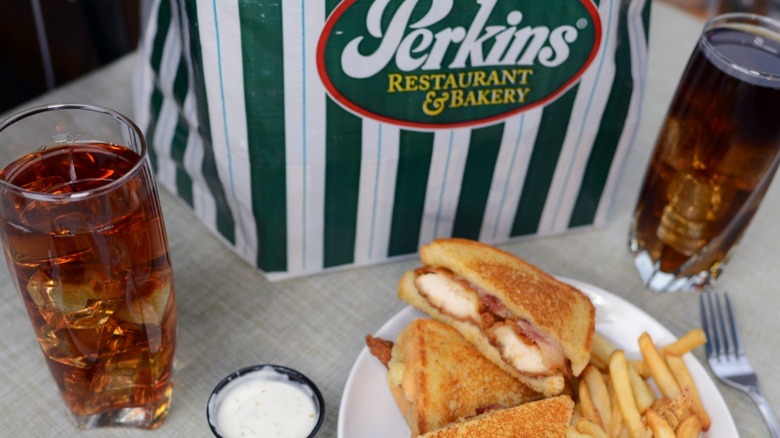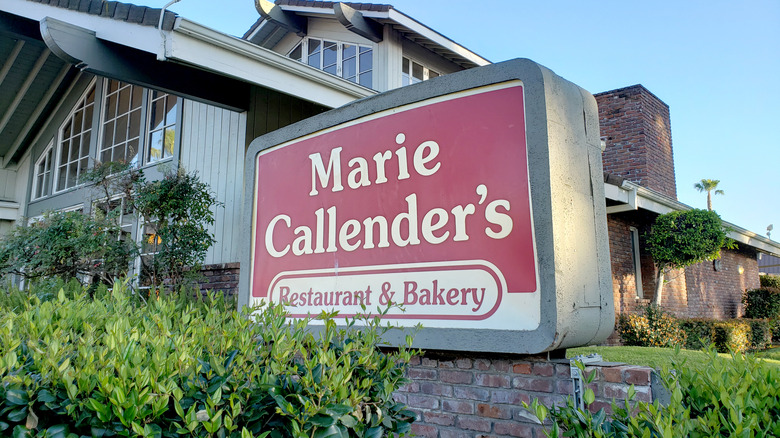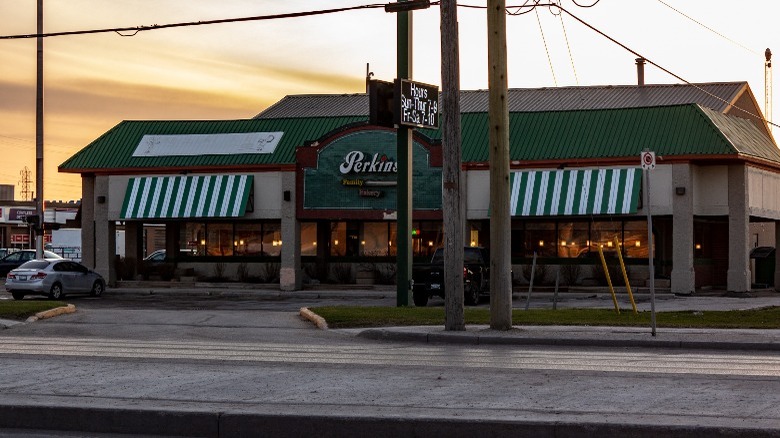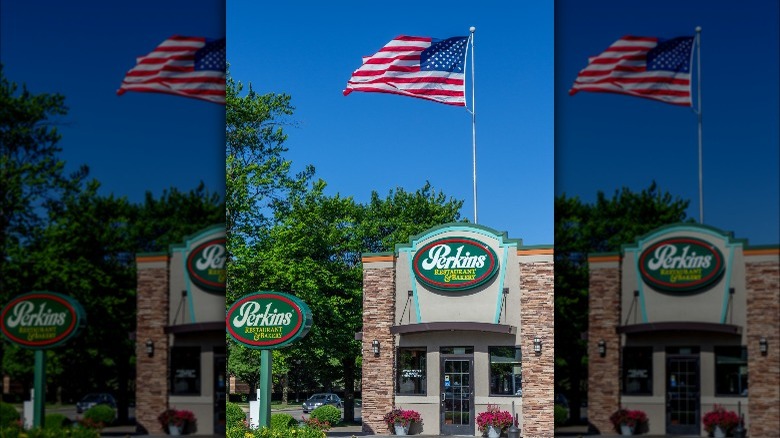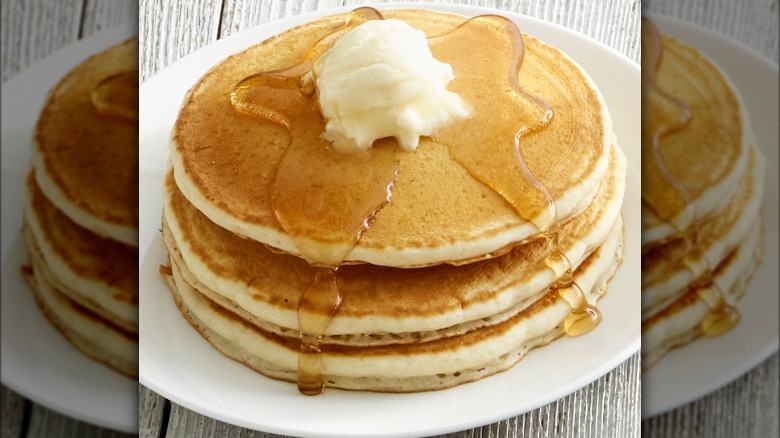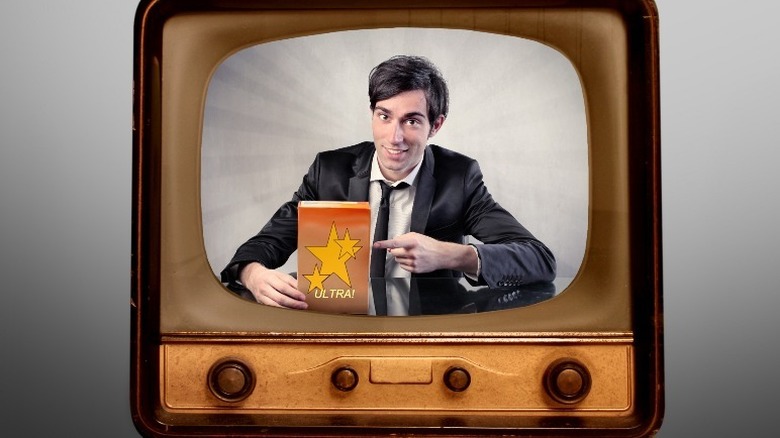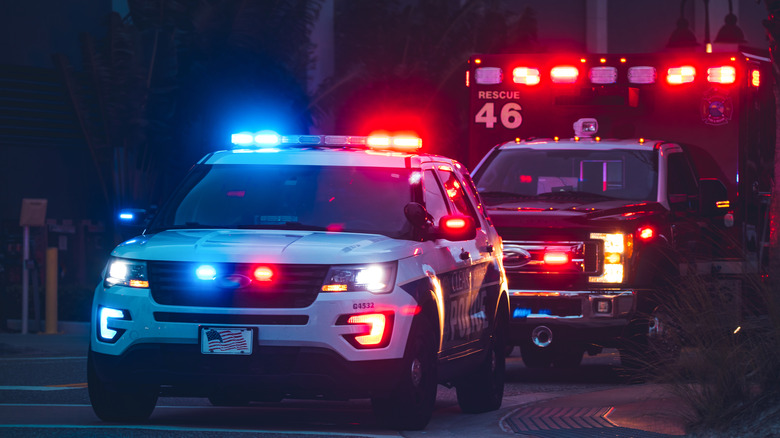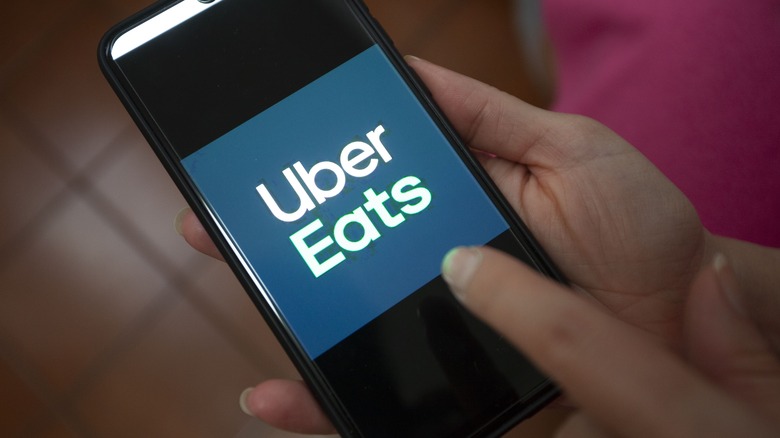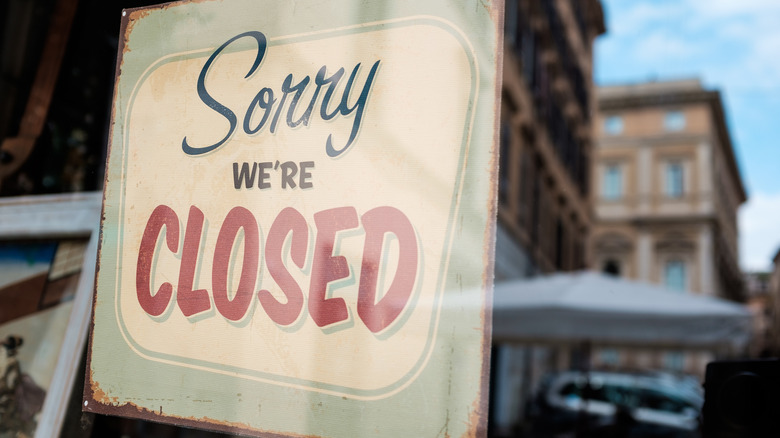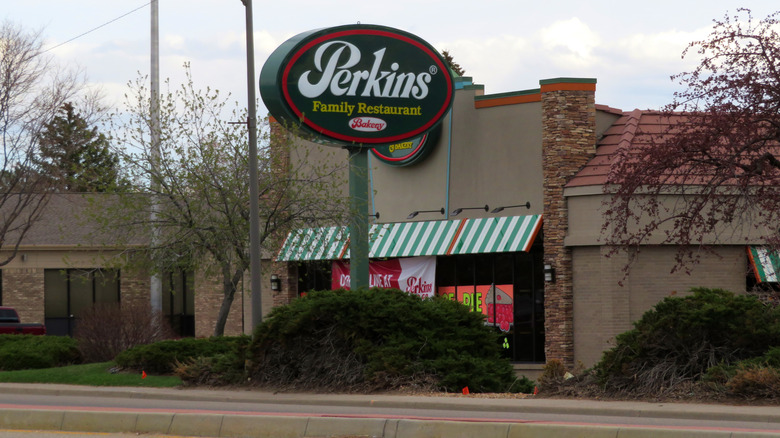Perkins Is Struggling To Stay Open. Here's Why
Perkins has been doing many things right, like serving breakfast all day, staying open on Christmas, and giving away free slices of pies (via Money). The chain's muffins are "mammoth" sized, pancakes are made from scratch (via Perkins), and veggie egg white omelets are Macho Man Randy Savage-approved (via Bleacher Report). But despite all that, surprisingly, Perkins Restaurant and Bakery has been struggling to keep its restaurants up and running. What's going on? In summary, the recession, housing crash, pandemic, labor crunch, franchisee fall-outs, and fires have all kept the chain from thriving like it used to in the late '50s and '60s.
More than six decades old, Perkins has changed many hands, and tried out new concepts to stay relevant. The chain shifted from breakfast only to an all-day restaurant in the late '60s, added an in-store bakery in the '80s, and introduced sport-themed rooms in the '90s (via Funding Universe). But even those measures didn't guarantee it long-term stability. Its rapid expansion in the '90s turned its financial situation a little wobbly, according to Funding Universe. In fact, that seemed to have kick-started a domino effect that kept the company fighting to find its legs. Here's why the beloved chain is struggling to stay afloat.
A Perkins merger didn't help its growth
The coming together of Perkins and California-based Marie Callender's in 2006 was a big moment in the pie-verse. Both establishments were founded even before bell-bottoms and turtlenecks had become a craze in the '60s. While those trends (thankfully) didn't withstand the test of time, the two eateries did. In fact, at the time of the merge, Perkins had 500 units, and Marie Callender's 138 (via Orange County Register). Though theirs seemed like a match made in heaven, it just wasn't strong enough to hold out against the barrage of financial troubles that followed. Within the first five years, the number of Perkins cafes had reduced to 450 and Marie Callender's to 89. The company had no way out but to file for a Chapter 11 bankruptcy.
So how did it get to this point?
According to a statement by the company, soon after the two bakery cafes had shaken hands to unite, things had turned hairy around the world. The housing crash of 2008, and the recession that ensued, threw a spanner on its future plans. At that point, eateries around the United States frantically introduced changes like tweaking their menus, lowering prices, and giving away coupons — all to retain customers, but many Perkins and Marie Callender's units just couldn't cope, and 58 of them closed. The worst affected were the restaurant's locations in California, Florida and Nevada, per Orange County Register.
One of its biggest franchises failed to pay royalties
Perkins owes a lot to its franchises. A main reason that it even expanded from being a little pancake house to one that serves both cakes and steaks, is a franchisee, per Funding Universe. As of 2019, 254 of its 369 stores were franchises (via FSR Magazine). So, obviously, it was a big blow for Perkins when one of its biggest franchisees, Pennsylvania-based Campbell Land Company, failed to pay royalty fees, transfer fees, and marketing fees that it owes to the chain. Perkins said that it tried to have a civilized conversation with the franchisee and resolve matters, but when that didn't help, it took matters to court, and sued Campbell (via FSR Magazine).
As per the 2019 lawsuit, Perkins demanded that Campbell shut down the 26 units that it had bought from Perkins in 2018. Turns out, Campbell didn't just not pay its due, but also didn't upgrade the restaurants, and dared to sell pork chops to customers, when pork chops was not even part of Perkins' menu (via FSR Magazine). In the lawsuit, Perkins unleashed its ire, banning Campbell from starting another restaurant within a three-mile radius of the Perkins locations, or use furniture, logos, and a menu that might look similar to what's used at Perkins — and yes, that applies to even the American flag that some Perkins restaurants adorn (via Sharon Herald).
Perkins went bankrupt for the second time in 2019
The first time Perkins went bankrupt, it blamed the recession. A private investment firm called Wayzata Investment Partners scooped the company up from the dregs, but that didn't make for a happily-ever-after ending. Perkins lost all the money again in just eight years, and filed for bankruptcy in 2019 (via Reuters). This time, they blamed a general lack of interest among customers toward family and casual dining industries. Technomic's 2017 report showed that casual dining chains were indeed facing a slump (via Restaurant Business).
Per Technomic's managing principal, Joe Pawlak, "Casual dining is still in a slump. We still think small chains and independents are performing at a better rate. Consumers want a unique experience when they go sit down at a restaurant." Perkins had nearly 400 stores spread across the U.S., Canada, and Mexico (via Reuters).
And Jeffrey Warne, Perkins' chief executive at the time, said that besides low customer traffic, what also created a money drought for the company were the rising commodity prices and rising minimum wages (via Reuters).
Perkins and Marie Callender's had to close 32 underperforming stores (via Reuters). But what helped Perkins stay afloat was a buy-out by Huddle House, a restaurant company, for more than $50 million. However, for this deal to happen, Perkins had to split from Marie Callender's (via Restaurant Business). Guess it was time for both the eateries to eat the humble pie and move on.
Perkins failed to innovate
Like the boomers who fail to connect with youth because of their inept TikTok skills, Perkins — born out of the late '50s — found it hard to please the relatively younger generation. One Redditor associated it with "old person food," while another said, "[...] I think it attracts the Boomers. Millennials go to Waffle House" (via Reddit).
To be fair, there is a good reason they thought so. While restaurants around the world seem to be restlessly innovating — New York City's Chobani is experimenting with a savory yogurt bowl, and IHOP is giving grab-and-go wraps a try (via Forbes) — Perkins was slacking off, per some franchisors. Roger Perron, who had owned Perkins franchises in Winnipeg, Canada, said that as many as seven Perkins locations shut down in his city between 2019 and 2020, and a key reason for this was an outdated menu (via Winnipeg Free Press).
Some items on the menu like the biscuit and gravy were not exactly what Winnipeg locals were tempted to dine out for. But what really chafed the franchisees was a lack of interest from the parent company to tweak the menu according to current trends and local tastes. So Perron and the other investors rebranded what used to be Perkins locations, and introduced more vegetarian and gluten free options in the menu to attract a younger crowd.
Its restaurant size is not the best for business
For a chain that frets about not getting enough customers to dine in (via Reuters), a sprawling 6,000 square feet space is a bit much. While restaurants across the U.S. shrank, Perkins just stared at its mostly empty seats. When Perkins appointed new Chief Development Officer Peter Ortiz in 2021, he noticed the massive real estate of the restaurant, and said, "[...] the day of those 5,000, 6,000, 7,000-square-foot places—that's just a dinosaur." (via FSR Magazine)
According to Ortiz, Perkins needn't have to be more than 4,100 square feet — especially when more than 50% of consumers heavily rely on carry-outs anyway, according to a report released by Nation's Restaurant News (via Hospitality Technology). Ortiz added that the new Perkins restaurants will be designed to include pickup lockers and mobile order windows, with takeout and delivery in mind.
With around 4,000 square feet as the limit, Perkins will be able to accommodate about 200 customers, with 2,400 square feet for kitchen and serving areas, per the calculation by Credibly. Reducing real estate has a ton of pros including lower construction costs, reduced operational costs and easy expansion, per QSR Magazine. Perkins should have probably woken up to the fact sooner. But, better late than never.
The chain lost its breakfast crowd due to Covid
With its pancakes, bacon strips, and hash browns, Perkins has had customers hurrahing the chain for its lip-smacking breakfast (via Trip Advisor and Reddit). The chain had a longer time to perfect its breakfast options, for it was the sole meal it offered in the late '50s before expanding its menu to include lunch and dinner (via Funding Universe). Even more than six decades later, the chain continues to be seen as a neighborhood breakfast spot. As its Chief Development Officer Peter Ortiz told FSR Magazine, "When people say Perkins, they think breakfast, but there's a huge population out there that knows us for lunch and dinner, as well." Perkins is open until midnight.
Given Perkins seemed to attract the breakfast crowd, when COVID struck, it saw its sales dip significantly. The breakfast industry went through a "disproportionate decrease" compared to lunch and dinner, Jose Cil, CEO of Restaurant Brands International, had said in an earnings call back in 2020 (via CNN Business). A study by the marketing company Acosta in 2020 revealed that 44% of the people surveyed said they had shifted to eating breakfast at home (via Supermarket News). Even as more people discovered the joy of making bread from scratch, Perkins felt the heat.
It wasn't proactively selling franchises
Though a majority of Perkins stores are franchises, the chain has been lackadaisical about expanding through the model. As its chief development officer Peter Ortiz told Franchise Times, "When I got here, there was no one selling franchises." When Ortiz joined the company in 2021, all that the company had to show for its efforts toward franchising was an application form and a brochure. Ortiz also noted that the chain had made little effort to expand into non-traditional locations such as universities, hospitals and military bases (via Franchise Times).
Ortiz, and Perkins and Huddle House CEO Michael Abt, brainstormed with the team to come up with a triple strategy of expansion: adding new franchises, expanding the ones that were already there, and cross-selling between the two brands (via Franchise Times). It wasn't all talk, Perkins did launch a National Franchise Initiative in May 2021 — two years after Huddle House had bought Perkins in 2019, according to FSR Magazine. Abt said they used data and market analysis to come up with a franchise model that had a better menu, more effective marketing strategies, and was more cost efficient. Perkins was finally ready to sell its franchises, but whether they would be as attractive as the chain's pies remained to be seen.
Its advertising strategy is outdated
For many of us, ads are those pesky little pop ups on our Facebook page; but Perkins, for some reason, has stuck to traditional television commercials that are probably as outdated as boot cut jeans. According to TechCrunch+, traditional advertising fell by 19% in 2019, and digital ad spending jumped by 19.1%. In 2020 the revenue from television ads dropped again by around 27%, per Standard Media Index, a company that tracks ad pricing (via Variety). Clearly, people were hopping onto streaming sites from television (via The Guardian), so why would companies even make TV ads? Perkins realized it a tad late.
Michael Abt, CEO of Huddle House and Perkins, told Franchise Times in 2021 that Perkins still used radio and television to advertise itself. But as its Chief Marketing Officer, Alison Delaney, said in a 2020 episode of FastCasual's QSRweb Podcast regarding the pandemic and pivoting, "Media consumption has changed dramatically over the past five months. And we don't know where it's all going to shake out, but people that have cut off their cable and have cut off their software, they're never going to bring that back." Translation: Perkins will have to change its old staid ways to stay relevant (via Epsilon).
Fires forced some Perkins locations to close
Besides the financial struggle that dragged the chain down under twice, there were other unforeseen accidents that added to the misery. Many of its locations had to shut down temporarily after being marred by fire. In 2014, one of its locations in Whitehall Township in Lehigh County, Pennsylvania, had to close because of a fire caused by an electrical malfunction (via Lehigh Valley Live). The next year, as a result of a kitchen accident, flames licked a location in Edinboro, Pennsylvania, enough to shut it down for six years (via Erie News Now). And many other locations, including the one in New Ulm, Minnesota (via The Free Press), another in Lawrence, Kansas (via LJWorld.com), yet another in Brooklyn, Ohio (via Fox8) were reported to have suffered damages due to fire.
In 2021 alone, there were as many as three incidents of fire accidents reported in Perkins restaurants. An accidental fire in the Perkins at Coralville, Iowa, cost the owners $500,000 in damages (via kcrg.com). The location in Hastings, Nebraska, shockingly, saw two fires in 25 days (via Bring Me The News), and a grill inside the Perkins in Altoona, Pennsylvania, reportedly caused a small fire (via WTAJ).
Shortage of labor
After the Perkins in Edinboro, Pennsylvania had to be shut down due to fire, its owner filed for bankruptcy and sold it to another, who was faced with an altogether new challenge. While the restaurant was renovated and ready to open, it struggled to get some staff to make it function like it used to (via Erie News Now). While the location was getting its walls and roof fixed, COVID had raged through the rest of the world, introducing among many other issues, a severe shortage of employees.
The restaurant threw its net wide, organizing hiring events, scouring social media, and partnering with a local school to hire students part-time. It had only filled 58 out of the 83 openings, with less than a month to go for its big reopening, in 2021, reports Erie News Now. And yet another Perkins restaurant had to shut down in 2021 — just a little over four years after it had opened in Apalachin, New York. The reason? It just couldn't get enough staff to work the shifts (via WNBF).
Chain restaurants are falling out of fashion
Perkin's can't solely contribute its bankruptcy to pandemic problems. Part of the brand's financial issues have to do with a cultural shift. As Bob Dylan once said, the times, they are a-changin'. Remember that trend from 2015 to 2017 when the internet kept claiming millennials were killing everything from the napkin industry and bar soap to marriage and the American dream? It turns out millennials were also busy killing casual restaurants.
Most prominently, so-called "breastaurants" took a hit, with Hooters closing 7% of its locations between 2012 and 2016. Buffalo Wild Wings, who have a similar beer and chicken model, struggled amidst rising chicken prices. Even old favorites like TGI Fridays, Ruby Tuesday, and Applebees had money problems. In fact, according to Insider, "2016 was the worst year for the restaurant industry since the recession."
In other words, things were going south for a lot of chain and franchise restaurants years before the pandemic forced them to physically shut the doors. Perkins likely wasn't excluded from the financial carnage. Victor Fernandez, an executive at the restaurant analytic company TDn2K, told Business Insider that it has to do with options. If Perkins wants a leg in the game, it's going to need to outcompete the growing list of competitors — which now includes meal subscription services, ghost kitchens, and app-based takeout and delivery.
Perkins owners are closing longtime locations
Even if Perkins was on track for record sales, it can't help the fact that some franchise owners have been opting out of business. In recent years, a handful of owners decided to permanently close beloved locations — some having served up pie and Mammoth Muffins for decades.
According to Shore News Network, in 2022, a prominent Perkins location in New Jersey shuttered its doors after 30 years of business when the owners decided to retire. Instead of transferring the business to new owners, the location was taken over by Brownstone Pancake Factory. This New Jersey-based breakfast restaurant hoped to open its fourth location sometime in the fall. In short: when one chain breaks, another begins. The competition is real.
A Perkins location in Maplewood, Minnesota also suffered a similar fate. According to the Minneapolis/St. Paul Business Journal, the owner, Debra Pedro, shuttered the restaurant after 42 years of business when her franchise agreement expired. At the time it closed, just two people worked at the franchise (Pedro and a cook) and their finances were partially subsidized by donations from customers. Another casual restaurant quickly swooped in to take its place.
According to some estimates, a whopping 60% of restaurants fail in their first year, and a further 80% don't make it past five — but when decades-old locations close, you know there's a real problem.
Can Perkins make a comeback?
Despite the recent hurdles, Perkins is determined to claw its way back to financial security, one baked good and greasy strip of bacon at a time. With bankruptcy behind them, the company has huge plans to expand — not only across the country, but with modern dining options that focus on customer convenience.
According to FSR, by May 2022, Perkins and its sister company Huddle House had inked 32 new franchise deals across nine different states. The parent company, Ascent Hospitality Management, solved the issue of Perkin's underused, oversized locations by slimming each new restaurant down by around 1,000 square feet and opening smaller Huddle House restaurants in underserved markets. Talk about maximizing profits.
The company also launched itself into the modern age of virtual food brands. First, it created two ghost kitchen concepts, MrBeast Burger and Papa Corazon's Quesadillas, which were integrated into more than 100 existing Perkins and Huddle House locations. Second, Perkins launched a bakery-only delivery concept, Bakery by Perkins, on popular food delivery apps like DoorDash, Uber Eats, and GrubHub. Essentially, Perkins is now everywhere your phone is — but will it be enough to save the sinking ship?
According to Chief Development Officer Peter Ortiz, the answer is a resounding yes. "We're in the strongest position we've been in for several years," he told FSR. Things are looking up.
